#breton folklore
Explore tagged Tumblr posts
Text

Teir Garan (2023)
Water birds were seen as magical in many Celtic folklores, as they were living in the three worlds (water, sky, and land), and often represented in groups of three. The Breton name of the crane, garan, also means "etching, carving, engraving", and garaniñ or garanañ means "to carve, to engrave". In Breton, the expression chom garanet (literally "to keep engraved") means to remember something vividly; and so, cranes were associated with memory and knowledge. This association can also be seen in Irish mythology, where some stories say that Manannán mac Lir's crane bag contained, on top of his many other treasures, the letters of the first Ogham, the Irish alphabet that was originally written carved on stones
(Reposting this one because I deleted the original post accidentally last year)
#art#digital art#animals#bird#birds#bird art#breton folklore#celtic art#krita#I've had a bit of an art block recently#so I've mainly doodled birds in my sketchbooks#maybe I'll show the ones I like the most
859 notes
·
View notes
Text
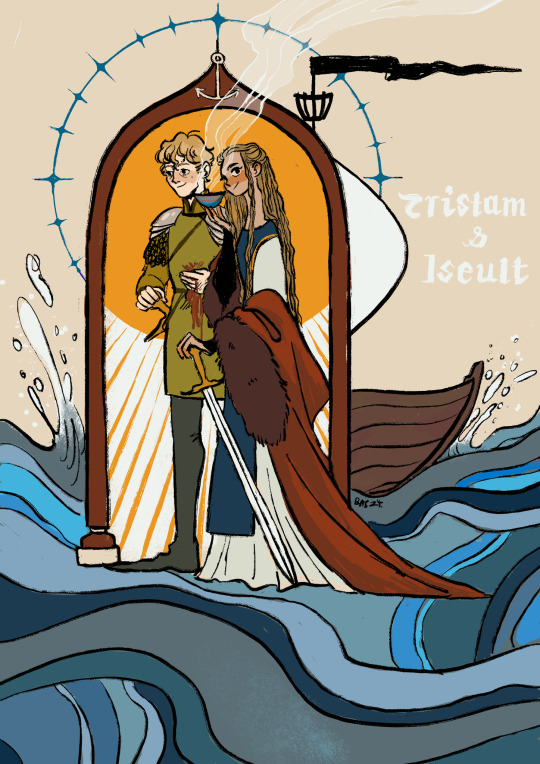
folkbruary #6
tristam & iseult
#ach this tale gets me every time#folk art#tristam and iseult#tristan and isolde#brythonic folklore#Cornish folklore#breton folklore#folklore art#fantasy art#cover art#digital illustration#folkbruary#folkbruary 24#basil draws
92 notes
·
View notes
Text
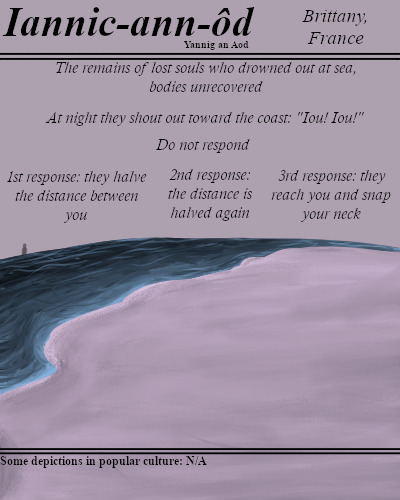
Take care and be aware, it takes only three return shouts for this spirit to reach you if it believes you are mocking them.
#BriefBestiary#bestiary#digital art#fantasy#folklore#legend#myth#mythology#iannic-ann-ôd#yannig an aod#ghost#spirit#undead#Iou! Iou!#lost soul#monster#breton folklore#breton legend
36 notes
·
View notes
Text
I think I found the chapel Morgan built/attends Mass. Here
Anyway Catholic!Morgan FTW
#eglise du graal#broceliande forest#catholic morgan le fay#val sans retour#morgan le fay#breton folklore#arthuriana
2 notes
·
View notes
Text
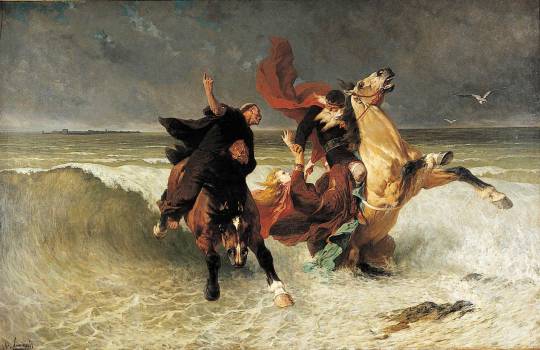
The Flight of King Gradlon, oil on canvas made around 1884 by Evariste-Vital Luminais
King Gradlon and the Legend of Ys:
"King Gradlon (Gralon in Breton) ruled in Ys, a city built on land reclaimed from the sea, sometimes described as rich in commerce and the arts. He lived in a wealth palace of marble, cedar and gold. In some versions, Gradlon built the city upon the request of his daughter Dahut, who loved the sea. To protect Ys from inundation, a dike was built with a gate that was opened for ships during low tide. The one key that opened the gate was held by the king.
Some versions, especially early ones, blame Gradlon's sins for the destruction of the city. However, most tellings present Gradlon as a pious man, and his daughter Dahut as a sorceress or a wayward woman who steals the keys from Gradlon and opens the gates of the dikes, causing a flood which destroys the whole city. A Saint (either St. Gwénnolé or St. Corentin) wakes the sleeping Gradlon and urges him to flee. The king mounts his horse and takes his daughter with him, but the rising water is about to overtake them. Dahut either falls from the horse, or Gradlon obeys a command from St. Gwénnolé and throws Dahut off. As soon as Dahut falls into the sea, Gradlon safely escapes. He takes refuge in Quimper and reestablishes his rule there." - Gradlon wikipedia article
#Evariste-Vital Luminais#art#The Flight of King Gradlon#bretagne#legend of ys#breton#breton folklore#brittany mythos
3 notes
·
View notes
Text
3rd March
St Winnol’s Day
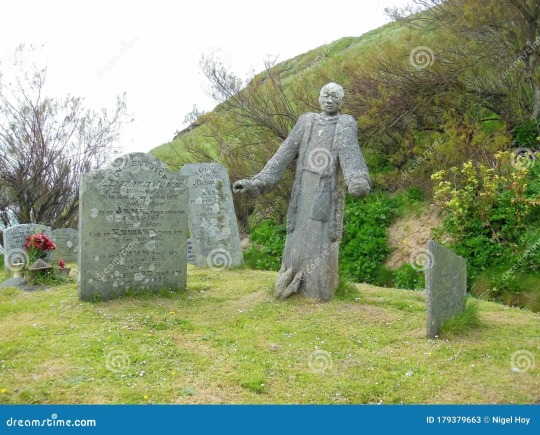
Source: Dreamstime.com
First comes David, then comes Chad,
Then comes Winnol, roaring like mad.
This folklore rhyme is just about all we know know about St Winnol, whose day it is today. He was a Breton saint in origin, named Winnaloe, and was a fierce ascete, insisting that his brothers join him in wearing hair shirts and prostrating themselves in front of the Lord. Winnol also had strange miracles attributed to him, including possession of a mysterious bell which, once sounded, would result in all the fish in a stream coming to him, and an ability to carry churches. Apparently the churches at East Portlemouth in Devon, and Lizard in Cornwall, owe their locations to Winnol.
Unsurprisingly, it is highly unlikely that Winnol ever existed.
1 note
·
View note
Text

Demat!
For the month of April, I am undertaking a special project to "solidify" Kroashent while I continue to work on the novel and the art. For the month, I will be making a special focus on developing and sharing the "Bestiary" of Alvez, showcasing the flora and fauna of the world of Kroashent. I hope to shift the focus each month with looking into characters, magic systems and geography, among others.
A lot of people have asked about the creatures of Alvez, and I always feel like my explanations are rather long-winded, daunting infodumps. It seemed like a great place to start to make my work a little more engaging.
Those familiar with my other work may be familiar with "Marie's Bestiary", a similar themed project sharing this information with in-universe commentary by the wandering troubadour. For this project, I'll be following a similar pattern, sharing the WorldAnvil Wiki pages. While I eventually hope to illustrate each of these entries, but for now, I'll be posting the entries themselves.
As always, feedback and inquiries are very helpful! I am always looking for ways to improve and flesh out my setting and stories and love enthusiastic engagement! I put a ton of work into these and hope you enjoy them!
--------------
Next up, by special request, the Teuz, the Korrigan of the Meadows
--------------
BTS: The Fairies of Brittany are the Korrigan, a diminutive magical people who inhabit the region. The Korrigan are numerous and varied, and often the terms are used quite interchangeably. Many Korrigan are portrayed in popular imagery as leprechaun-like dwarves, sometimes with horns, pointed ears and goat-like hooves.
In Alvez, there are many kinds of Korrigan, drawing from imagery that I have found in my research any my own interpretations. For the meadow-dwelling Teuz, I went with this faun/satyr like design as a nod to this popular imagery, as the Teuz are the most populous Korrigan people in Alvez, and the closest to humanity in terms of their living space. They live an agrarian lifestyle, similar to most rural peasantry, and take part in all walks of daily life in the region.
0 notes
Text
MY Holy Trinity™ of esc



#i call this specific vibe 'music to listen to while performing pagan rituals in the woods'#it's about the 🌱🕯️✨FOLKLORE✨🕯️🌱#no but seriously shoutout to go_a alvan & ahez and pasha parfeni for bringing songs about the folklore of their respective cultures to esc#AND sung in ukranian breton and romanian!!!#go_a#shum#Шум#alvan & ahez#fulenn#pasha parfeni#soarele şi luna#eurovision#eurovision song contest#eurovision song contest 2021#eurovision song contest 2022#eurovision song contest 2023#esc#esc 2021#esc 2022#esc 2023#my gifs#my gifset
805 notes
·
View notes
Text

#evariste-vital luminais#la fuite du roi gradlon#1884#art#painting#painter#bretagne#breton#breizh#brittany#celtic#legend#legandary#ys#finistère#douarnenez#france#french#xix century#folklore#history#culture#europe#european#ocean
21 notes
·
View notes
Text










Medieval Women Week || Favorite fictional medieval woman ↬ Melusine
In this, the novel follows in a long tradition of artistic and scholarly fascination for the puzzling figure who is Mélusine. Indeed, there has been much critical debate on her true nature: some scholars see Mélusine as a benevolent fairy lover, some categorize her as a foundational ancestor or mother goddess figure, whilst others argue that her serpentine nature links her with demons, the Eden serpent or the monstrous races of sirens, undines, and succubi. However, Mélusine’s character is so remarkably ambiguous and multifaceted that it is misleading to attempt to define her by one particular characteristic alone. Just as Mélusine’s body continually changes – from human to hybrid and eventually to animal – so does her character, allowing for a multitude of possible readings. Undoubtedly, it is this flexibility and open-endedness which lies at the root of the ongoing fascination with the Mélusine story and with her hybrid body. Nowadays, Mélusine’s monstrous figure not only appears in a postmodern novel such as Possession but is also found in video games, fantasy literature, graphic novels, gothic metal songs, and the logo of a well-known coffee chain. — The Mélusine Romance in Medieval Europe: Translation, Circulation, and Material Contexts by Lydia Zeldenrust
#medievalwomenweek#melusine#house of plantagenet#house of lusignan#breton mythology#french folklore#house of luxembourg#mythology and folklore#medieval
25 notes
·
View notes
Text
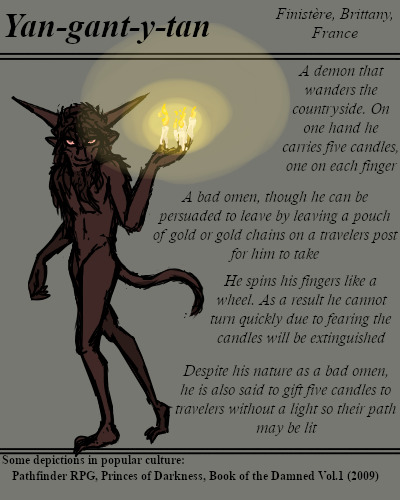
The nocturnal demon that wanders the countryside, his appearance is that of a wild man or troll.
Interestingly, his candle-holding hand has been compared to the Hand of Glory legend.
#BriefBestiary#bestiary#digital art#fantasy#folklore#legend#myth#mythology#yan-gant-y-tan#demon#breton folklore#breton legend#demon folklore#nocturnal demon#night demon
15 notes
·
View notes
Text
For Breton mythology, I'd suggest tracking down a few collections. These are all fairly well regarded and easy to find. The biggest challenge to researching Breton folklore is that many of the sources are in French. These are a few that I've found helpful in my own projects as a jumping off point:
Legends and Romances of Brittany by Lewis Spence [1917]. Spence's book is fairly easy to find online. Its also in English, so is pretty accessible.
The works of Émile Souvestre, specifically Le Foyer breton (The Breton Hearth) [1844] is another influential collection. I believe there are English translations, but its much easier to find in French.
Similarly, Antole le Braz is another well-regarded Breton folklorist. La Légende de la mort en Basse-Bretagne [1893] is an excellent collection of Breton death folklore and focuses a lot on the Ankou, one of the most memorable characters in Breton folkore. Again, easy to find in French, but I think there are English translations out there. He has other folklore collections as well.
Going back further, the Lais of Marie de France [12th Century] are well preserved and easy to find translated online. These are 12 (possibly more) poems that delve into both medieval courtly love and older Breton folklore.
Hope these help give you some insight into the fascinating world of Breton folklore!
Anybody have recommendations for books on Arthurian legends and Breton mythology? Preferably something I can download on kindle as I’ve zero space in my flat!
40 notes
·
View notes
Text
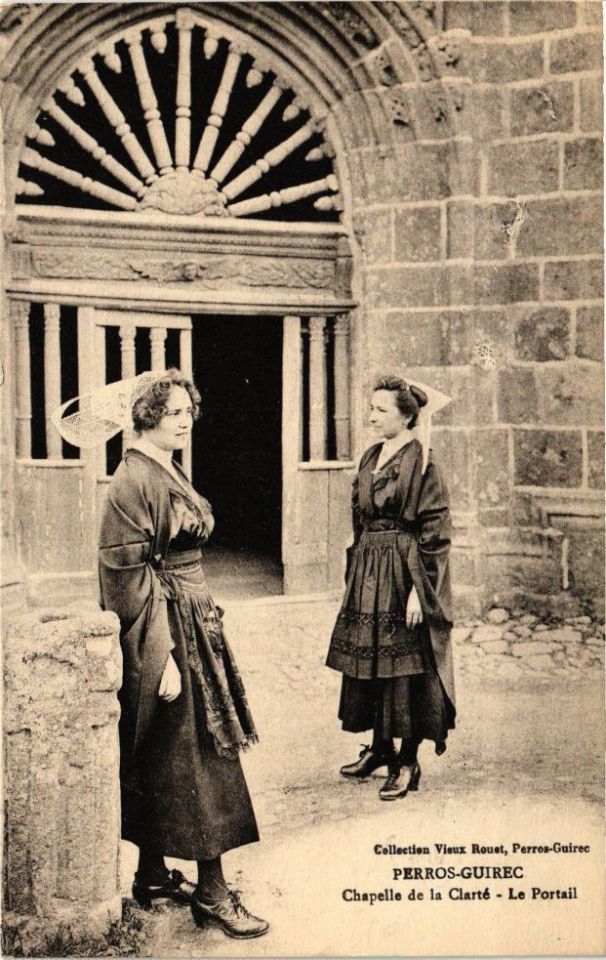
Breton folklore garments and the chapel of La Clarté, Perros-Guirec, Brittany region of France
French vintage postcard
#vintage#folklore#tarjeta#france#old#briefkaart#breton#chapel#postcard#la#photography#region#postal#carte postale#garments#sepia#ephemera#perros#brittany#historic#french#ansichtskarte#guirec#clart#postkarte#perros-guirec#postkaart#photo#la clarté
13 notes
·
View notes
Text

Copy & paste this in Google Translate Auto Detect & into English:
Chuidich na beòthachaidhean sin mi gus mo leasachadh mar an neach a tha mi. Ge bith dè an ìre de Inbheach, Jock, Janegirl no Nerd a th’ annam. Bidh mi an-còmhnaidh a’ comharrachadh mo thraidiseanan mar an teis-meadhan airson cò tha mi -Nate St Aidan- mar Fhrangach-Quebec, Acadien, Gàidhlig, ('s dòcha Metis) Neo-nàiseantach, Neach-iomairt, Ceannard & dìonadair.
Bidh mi a’ coisrigeadh a’ mhìorbhail seo a thaobh far am biodh daoine beòthail nan robh cothrom aca air beatha nas fheàrr no eadar-dhealaichte ann an Atlantic Canada. Dìreach mar a tha Glooskap & alt beul-aithris a’ fuireach an seo am measg cridheachan is subhachasan sgeulaichean.
#cartoon#animation#cape breton#prince edward island#nova scotia#halifax#new brunswick#atlantic ocean#arctic ocean#gravity falls#maps#proud family#kevin stoley#red mcarthur#south park#amphibia#anne boonchuy#catholic#conservative#atla#teen titans#owl house#amity blight#libertys kids#clone high#teletoon#acadien#jinx#arcane#folklore
4 notes
·
View notes
Text
do you ever make just. a fun little sacrificial horny idfic oc.
like welcome to existence my dude you're about to have the worst time but fortunately you will be turned on by it and more importantly so will I
#Menw is going in the soup#... not the original folkloric one to be clear#if I mention Menw I'm talking about my khajiit mage who is named after that other guy#though that other guy did also have a hell of a time#no I didn't even try to turn it into a lore friendly khajiit name maybe he was raised by bretons or something
5 notes
·
View notes
Text
Benjamin Péret Dicht in 't Frans
bron beeld: reze.fr De gepijnigde meisjes Dicht bij een huis van zon en witte haren / geeft een bos latente tederheden bloot / en een geest vol scepsis Waar is de reiziger vraagt zij De woudreiziger vraagt zich af wat de morgen zal brengen / Hij is ziek en naakt / Hij vraagt flikjes en men brengt hem dollegras / Hij is beroemd als de machine / Hij vraagt zijn hond / en ‘t is een moordenaar die ‘n…

View On WordPress
#19-de en 20-ste eeuws#anarchist#André Breton#écriture automatique#criticus#Dadaisme#dichter#Durrutti#Frans#Indiaanse folklore#Manifest#schrijver#Spaanse Burgeroorlog#Surrealisme#Trotskist
4 notes
·
View notes